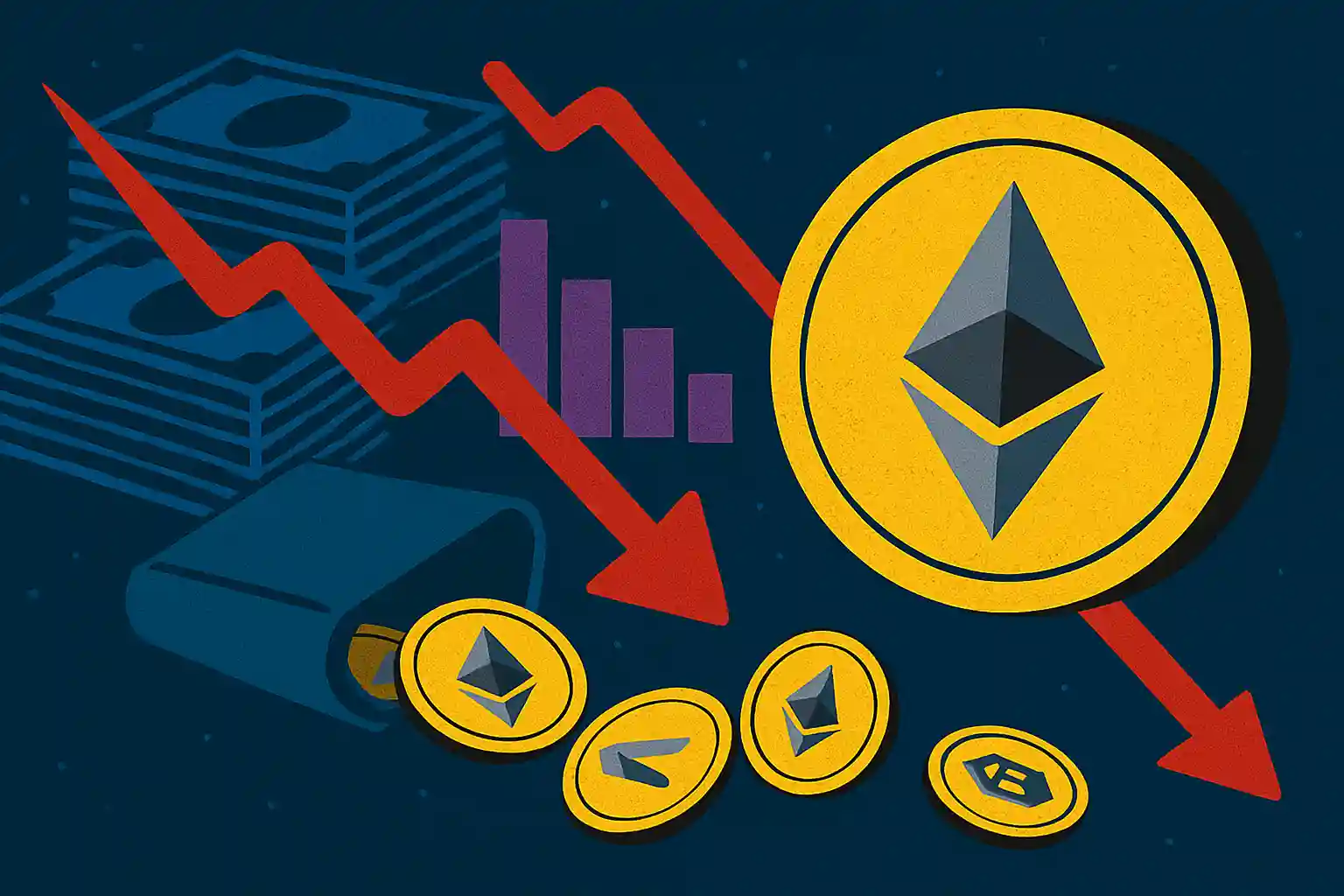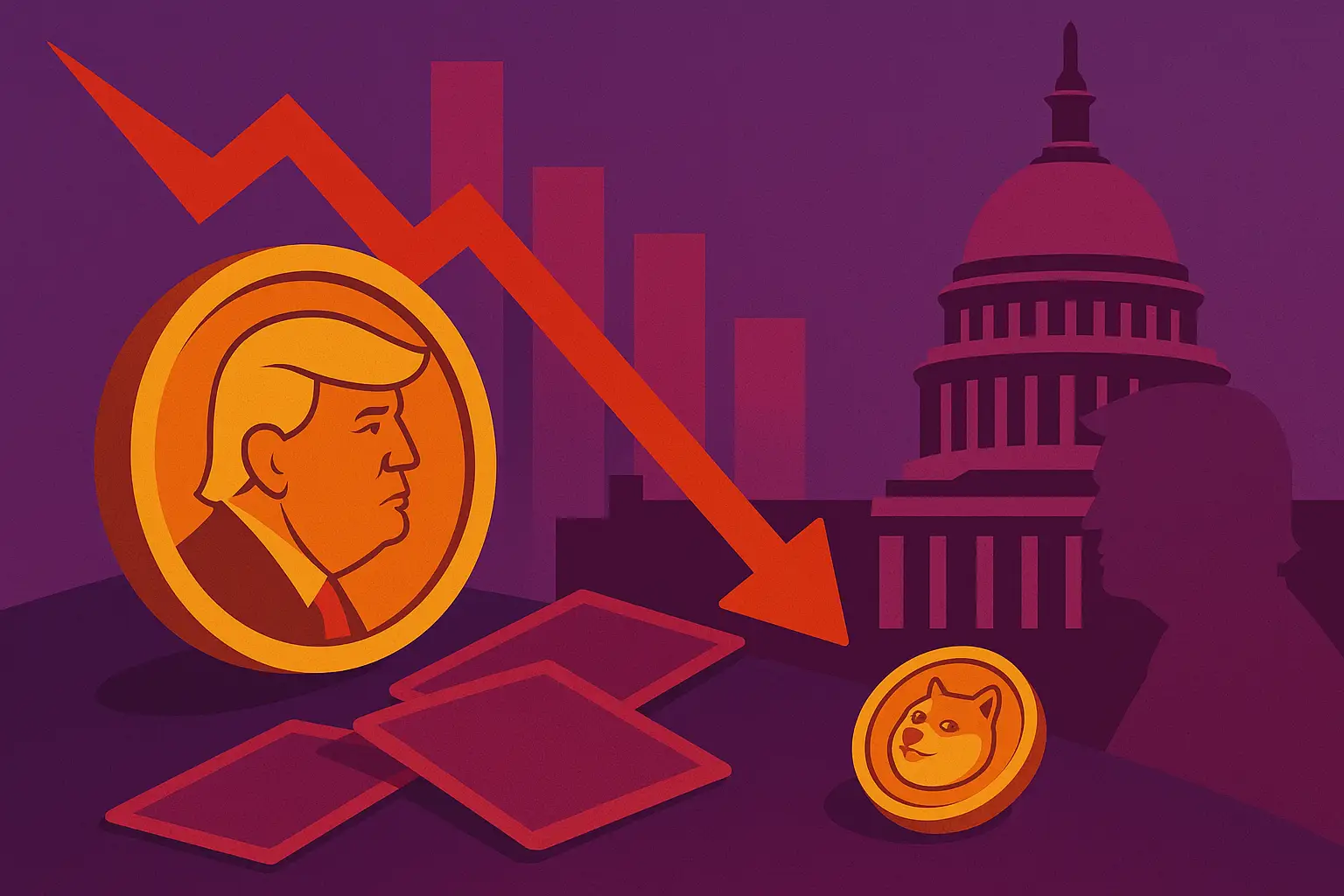In Brief
Crypto whales accumulated $1.77 billion across three altcoins—Cardano, Chainlink, and Ethena—ahead of September 16-17 FOMC meeting expecting first 2025 rate cut.
Cardano whales added 120 million ADA worth $103 million since September 9, maintaining positions through pullback with breakout target above $0.90.
Chainlink whale holdings surged from 538.54 million to 574.41 million LINK representing $843 million accumulation, positioning for inverse head-and-shoulders breakout above $25.96.
Ethena whales absorbed 1.2 billion ENA tokens worth $828 million through aggressive dip-buying despite 12% weekly decline, betting on hidden RSI divergence.
Whale positioning contrasts with retail caution as large holders anticipate dovish Fed pivot will catalyze altcoin rallies across rate-sensitive tokens.

Crypto whales are deploying substantial capital across select altcoins ahead of the Federal Reserve’s September 16-17 FOMC meeting, where markets anticipate the first rate cut of 2025 with high probability. While retail traders adopt cautious positioning and preserve capital for potential post-announcement opportunities, large holders are building significant positions in tokens they expect will benefit from dovish monetary policy signals.
The divergence between whale accumulation and retail hesitation creates a revealing dynamic where sophisticated players with deeper pockets and longer time horizons are positioning ahead of the catalyst rather than waiting for confirmation—a pattern that historically precedes substantial price movements when their thesis proves correct.
Cardano: Steady Accumulation Into Strength and Weakness
Cardano has attracted sustained whale buying through September, with on-chain data revealing coordinated accumulation across multiple large holder cohorts. Since September 9, addresses holding more than 1 billion ADA increased their collective stash from 1.88 billion to 1.94 billion tokens—a 60 million ADA addition. Simultaneously, the 10 million to 1 billion ADA cohort expanded holdings from 3.75 billion to 3.81 billion tokens, adding another 60 million ADA.
Combined, these whale tiers accumulated approximately 120 million ADA worth roughly $103 million at current prices near $0.86. The magnitude of this accumulation becomes more significant when examining the timing and price context of the buying activity.
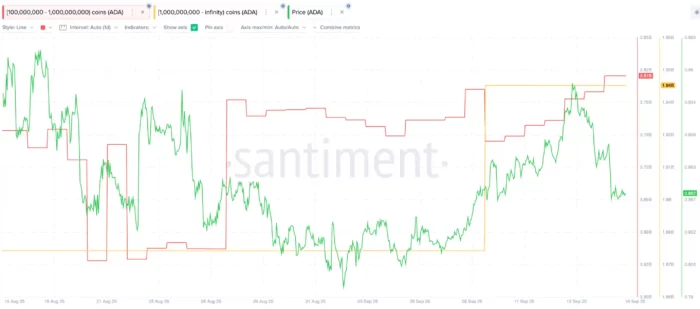
Accumulation Pattern Reveals Conviction
Crypto whales initiated Cardano buying while price was climbing toward $0.95, demonstrating willingness to purchase into strength rather than waiting for corrections—a behavior typically indicating high conviction about near-term catalysts. More tellingly, these holders maintained positions and continued accumulating through the recent pullback, refusing to take profits despite price retreating from local highs.
This buy-and-hold behavior through volatility suggests whales view current levels as attractive entry points rather than temporary trading positions. The absence of distribution during the pullback indicates these holders are positioning for moves beyond short-term volatility, likely anticipating the FOMC meeting will provide the catalyst that validates their accumulation.
The technical structure supports this positioning strategy. Cardano trades within an ascending triangle formation with support established near $0.85—precisely where whale buying has intensified. Ascending triangles typically resolve upward as consolidation compresses volatility before breakouts, making the pattern complementary to whale accumulation timing.
A move above $0.87-$0.90 would confirm the triangle breakout and project initial targets toward $0.96, with extended upside potentially reaching the psychological $1.00 threshold. These targets align with the risk-reward parameters that would justify the scale of whale capital deployment observed.
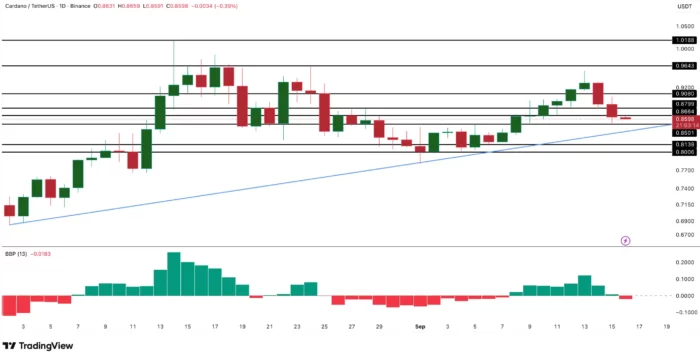
Retail Indecision Contrasts With Whale Confidence
The Bull-Bear Power indicator reveals oscillation between green and red readings across recent sessions, reflecting retail trader indecision about directional bias. This hesitation is understandable given the FOMC meeting uncertainty and recent price volatility that has whipsawed shorter-term participants.
However, the contrast between retail indecision and whale accumulation creates the precise conditions where large holders often generate outsize returns. By building positions while smaller traders hesitate, whales establish favorable entry prices before the catalyst that might convert hesitation to conviction triggers broader participation.
The invalidation level sits at $0.80, representing approximately 7% downside from current levels. This relatively tight stop-loss versus the 15%+ upside to initial targets above $0.95 creates favorable risk-reward that explains whale willingness to commit substantial capital despite near-term uncertainty.
Chainlink: Aggressive Positioning for Technical Breakout
Chainlink has witnessed the largest absolute dollar accumulation among crypto whales buying ahead of the FOMC meeting, with holdings expanding dramatically since early September. Whale addresses increased collective LINK positions from 538.54 million to 574.41 million tokens since September 4—a gain of nearly 36 million LINK representing approximately $843 million at current prices near $23.50.
This accumulation represents the most sustained and aggressive whale buying among the three highlighted tokens, suggesting Chainlink may be the highest-conviction position for large holders anticipating Fed-driven volatility.
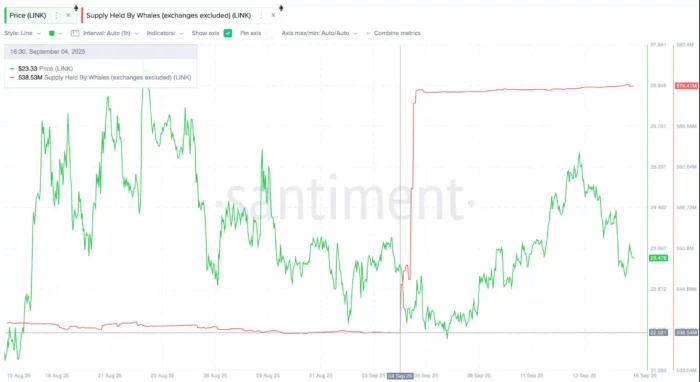
Buying Through Volatility Demonstrates Patience
The accumulation timeline reveals strategic positioning rather than momentum chasing. Crypto whales initiated buying when LINK dipped below $22, capturing discounted prices during weakness. Critically, they continued adding positions as price recovered toward current levels, demonstrating that accumulation strategy focused on building size rather than optimizing entry precision.
This through-cycle buying—adding during dips and continuing through rebounds—indicates whales are filling predetermined position sizes rather than trading around volatility. Such behavior typically characterizes institutional-style accumulation where large entities need weeks to build positions without moving markets, accepting price variation around a target average rather than attempting perfect timing.
The absence of distribution during price strength confirms these aren’t short-term trades being rotated for quick profits. Whales appear positioned for a move substantially beyond current levels, likely targeting the technical breakout scenario that chart structure suggests.
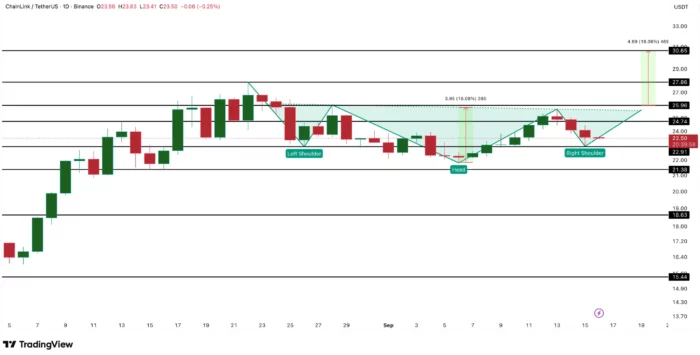
Inverse Head-and-Shoulders Projects Substantial Upside
Chainlink’s chart displays a developing inverse head-and-shoulders pattern—a classic reversal formation that often marks transitions from downtrends to uptrends. The pattern’s neckline sits near $25.96, representing the critical resistance level that must break for bullish confirmation.
If LINK achieves a clean daily close above $25.96, the measured move derived from the pattern’s depth projects minimum targets near $30.65. This represents approximately 30% upside from current levels—a gain magnitude that justifies the $843 million whale accumulation when risk-adjusted against the invalidation level.
The pattern would fail if price declines below $22.91, erasing the formation’s structure. This downside threshold sits roughly 2.5% below current prices, creating an attractive asymmetric risk profile where potential gains substantially exceed potential losses from invalidation.
Whale positioning suggests these holders anticipate the FOMC meeting could provide the catalyst that triggers the neckline breakout. Dovish Fed commentary signaling rate cuts would typically benefit risk assets broadly, with tokens showing strong technical setups likely experiencing amplified gains as technical and fundamental catalysts align.
The $843 million accumulation scale indicates this isn’t speculative positioning by a few entities but rather coordinated accumulation across multiple large holders who’ve independently reached similar conclusions about Chainlink’s setup into the FOMC meeting.
Ethena: Dip-Buying Despite Sharp Correction
Ethena presents the most contrarian whale accumulation scenario, with crypto whales aggressively buying through a sharp correction that has driven away most other participants. The token’s connection to yield-bearing stablecoin USDe creates rate policy sensitivity that makes FOMC outcomes particularly relevant for demand dynamics.
The 100 million to 1 billion ENA holder cohort held approximately 4.46 billion tokens on September 10 when price traded near $0.81. Since then, their holdings expanded to 5.66 billion tokens even as price declined to $0.69—representing accumulation of roughly 1.2 billion ENA worth approximately $828 million at current levels.
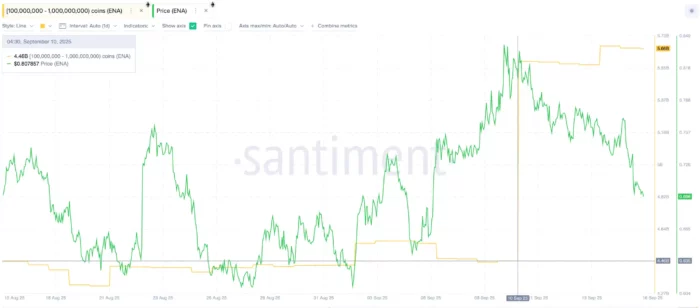
Aggressive Dip-Buying Reveals Strong Conviction
The accumulation timeline reveals remarkably aggressive buying behavior. Crypto whales initiated positions near the local peak around $0.81 and continued accumulating throughout the decline to $0.69—a 15% drop that typically triggers selling rather than buying from most market participants.
This sustained dip-buying through a sharp correction demonstrates extraordinary conviction that current prices represent value despite near-term weakness. Most holders—retail and many institutions—reduce exposure during corrections to limit losses or preserve capital. Whales doing the opposite suggests they possess strong fundamental or technical thesis that gives confidence price will recover substantially.
The scale of accumulation is particularly notable: 1.2 billion tokens represents approximately 27% expansion in this cohort’s holdings over roughly one week. Such rapid position-building typically occurs when sophisticated holders identify what they perceive as significant dislocations between current price and fair value.
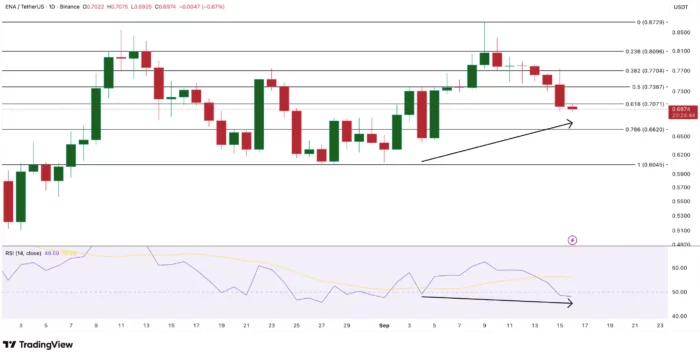
Hidden Bullish Divergence Provides Technical Justification
Despite the 12% weekly decline and nearly 10% single-day drop, Ethena’s chart displays a hidden bullish divergence on the Relative Strength Index that provides technical support for whale accumulation thesis. Between September 4 and September 16, price established a series of higher lows while RSI simultaneously formed lower lows.
This divergence pattern indicates selling pressure is weakening even as price continues declining—momentum is shifting bullish despite price action appearing bearish. Hidden bullish divergences specifically appear during uptrends experiencing corrections, signaling the larger uptrend will likely resume once selling exhausts.
The pattern suggests ENA’s correction represents temporary weakness within a larger bullish structure rather than trend reversal—precisely the scenario where aggressive dip-buying generates optimal returns if the divergence resolves upward as technical theory suggests.
ENA currently trades at $0.69 with immediate resistance at $0.73. A daily close reclaiming this level would confirm the divergence is resolving bullishly and project recovery targets toward $0.80 initially, with extended upside potentially reaching $0.87. These targets represent 16-26% gains from current levels.
The invalidation threshold sits at $0.60, approximately 13% below current price. If ENA breaks this support, the bullish divergence would fail and suggest the correction has further to run. However, whale accumulation scale suggests large holders view this scenario as low probability.
Rate Cut Expectations Drive Positioning
The September 16-17 FOMC meeting carries particular significance as markets price in the Federal Reserve’s first rate cut of 2025 with high probability. This pivot from tightening to easing represents a fundamental shift in monetary conditions that historically benefits risk assets, particularly cryptocurrencies sensitive to liquidity conditions.
Rate cuts reduce opportunity costs of holding non-yielding assets like cryptocurrencies compared to bonds and savings accounts. Lower rates also tend to weaken the dollar, making dollar-denominated crypto assets more attractive. Most importantly, rate cuts signal increased liquidity that tends to flow toward risk assets as investors seek returns beyond declining fixed-income yields.
The tokens crypto whales are buying ahead of this meeting share characteristics that position them to benefit disproportionately from dovish Fed outcomes:
Cardano’s ascending triangle structure needs a catalyst to trigger breakout—rate cut optimism could provide that spark while supporting follow-through.
Chainlink’s inverse head-and-shoulders requires momentum to break neckline resistance—improving risk sentiment from Fed easing would favor such technical breakouts.
Ethena’s USDe stablecoin competes with traditional dollar yields—declining rates make USDe’s yield more attractive relative to alternatives, potentially driving demand for ENA.
Whale vs Retail Positioning Divergence
The contrast between whale accumulation and retail caution creates revealing market dynamics. Retail traders are preserving capital to deploy after the FOMC meeting provides clarity, reasoning that waiting for confirmation reduces risk of being wrong-footed by unexpected hawkish outcomes.
Crypto whales are taking the opposite approach—building positions before the catalyst rather than after, accepting the risk that Fed commentary disappoints in exchange for positioning at more favorable prices if their thesis proves correct.
This divergence reflects different operational realities and risk tolerances. Retail traders typically operate with shorter time horizons, tighter risk management, and less capital to deploy, making waiting for confirmation rational. Whales operate with longer horizons, can tolerate larger drawdowns, and need time to build substantial positions without moving markets—making pre-catalyst accumulation necessary.
Historically, periods where whale accumulation diverges sharply from retail sentiment often precede significant moves in the direction whales are positioning. Large holders don’t always prove correct, but their track record suggests their positioning deserves attention as a signal about where sophisticated capital sees opportunity.
Risk Factors That Could Invalidate Thesis
Despite substantial whale accumulation, several scenarios could invalidate the bullish positioning and trigger losses:
Hawkish Fed surprise: If the Fed maintains rates or signals fewer cuts than expected, risk assets would likely decline sharply as the catalyst whales are anticipating fails to materialize.
- Weak follow-through: Even if the Fed cuts rates, sustained rallies require technical levels to break cleanly. Failed breakout attempts would trap positioned bulls.
- Broader market weakness: If equity markets or Bitcoin decline despite Fed easing, altcoins would struggle to rally against negative correlation pressures.
- Technical invalidations: Each token has defined breakdown levels ($0.80 for ADA, $22.91 for LINK, $0.60 for ENA) that would negate bullish structures if breached.
The concentration of $1.77 billion in whale accumulation across just three tokens also creates correlated risk. If the thesis proves wrong, selling pressure would likely hit all three simultaneously as whales exit failed positions.
What the Accumulation Scale Reveals
The combined $1.77 billion in whale accumulation across Cardano ($103M), Chainlink ($843M), and Ethena ($828M) represents substantial capital deployment that provides insight into sophisticated holder conviction levels.
This isn’t speculative position-taking with minor capital—it represents meaningful allocations that would require strong fundamental or technical justification. The scale suggests these aren’t isolated whale decisions but rather coordinated accumulation across multiple large holders who’ve independently reached similar conclusions about FOMC-driven opportunity.
The positioning also reveals which tokens large holders view as having highest beta to Fed policy outcomes. Chainlink’s $843 million leading accumulation suggests it may be viewed as the highest-conviction play on rate cut catalysts, while Ethena’s aggressive dip-buying indicates whales see the correction as creating exceptional entry opportunity.
For market participants, whale positioning doesn’t guarantee success but provides valuable information about where sophisticated capital sees asymmetric risk-reward. The $1.77 billion committed to these three tokens ahead of the FOMC meeting represents a clear thesis: dovish Fed outcomes will disproportionately benefit these specific altcoins through combination of technical setups, fundamental sensitivity to rates, and current valuation dislocations.
The next 48 hours will reveal whether this positioning proves prescient or premature, but the scale of accumulation ensures these tokens will be among the most volatile and potentially profitable in either direction as the Fed’s decision becomes clear.


